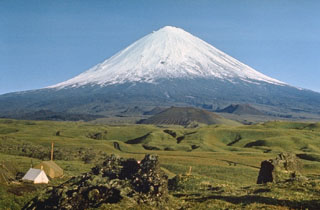Report on Klyuchevskoy (Russia) — January 1980
Scientific Event Alert Network Bulletin, vol. 5, no. 1 (January 1980)
Managing Editor: David Squires.
Klyuchevskoy (Russia) Tephra and lava flow
Please cite this report as:
Global Volcanism Program, 1980. Report on Klyuchevskoy (Russia) (Squires, D., ed.). Scientific Event Alert Network Bulletin, 5:1. Smithsonian Institution. https://doi.org/10.5479/si.GVP.SEAN198001-300260
Klyuchevskoy
Russia
56.056°N, 160.642°E; summit elev. 4754 m
All times are local (unless otherwise noted)
Tass reported, in an article dated 24 January, that Kliuchevskoi had begun to erupt. Gas, ash, and "hot rocks" were ejected, and a lava flow was extruded. Heavy snowfall impeded observation of the crater, but the staff of the local IVP station were monitoring the volcano with instruments.
Geological Summary. Klyuchevskoy is the highest and most active volcano on the Kamchatka Peninsula. Since its origin about 6,000 years ago, this symmetrical, basaltic stratovolcano has produced frequent moderate-volume explosive and effusive eruptions without major periods of inactivity. It rises above a saddle NE of Kamen volcano and lies SE of the broad Ushkovsky massif. More than 100 flank eruptions have occurred during approximately the past 3,000 years, with most lateral craters and cones occurring along radial fissures between the unconfined NE-to-SE flanks of the conical volcano between 500 and 3,600 m elevation. Eruptions recorded since the late 17th century have resulted in frequent changes to the morphology of the 700-m-wide summit crater. These eruptions over the past 400 years have originated primarily from the summit crater, but have also included numerous major explosive and effusive eruptions from flank craters.
Information Contacts: Tass.

